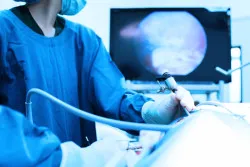 Karl Storz Endoscopy-America Inc. is facing a new power morcellator lawsuit from a New Jersey woman for damages she suffered as a result of the device used during her laparoscopic hysterectomy.
Karl Storz Endoscopy-America Inc. is facing a new power morcellator lawsuit from a New Jersey woman for damages she suffered as a result of the device used during her laparoscopic hysterectomy.
In 2008, 34-year old plaintiff Sophia E. underwent a laparoscopic hysterectomy procedure to treat uterine fibroids.
Following the laparoscopic power morcellation, Sophia alleges she developed serious fibroid complications as a result of the company’s power morcellator used during her hysterectomy.
Specifically, Sophia claims that Storz’s Rotocut Power Morcellator caused her to develop parasitic myomas, an unusual growth pattern of leiomyomas (fibroids). She contends that as a result of the use of the Rotocut Power Morcellator, fibroid tissues were spread and seeded throughout her abdominal cavity and pelvic region.
This made it necessary for Sophia to undergo two additional surgeries to remove the leiomyomas.
Sophia will most likely need additional surgery to correct the continuous fibroid problems, allegedly caused by her initial March 2008 hysterectomy.
In the power morcellator lawsuit, Sophia states she is worried that any additional surgery will leave scarring or permanent disfigurement.
Overview of Power Morcellator Complications
Laparoscopic power morcellation is highly preferable among women who are undergoing hysterectomy or other similar surgical procedures to remove uterine fibroids, due to the accuracy and minimally invasive nature of these devices.
It is currently estimated 650,000 women will undergo a surgical hysterectomy or myomectomy to to remove uterine fibroids per year, with many of them opting for laparoscopic power morcellation.
Morcellation is the procedure of cutting up tissue into smaller pieces, which is often used in laparoscopic surgeries for easy removal of uterine fibroids. A small incision is made in the abdomen, from which the uterine fibroid fragments are vacuumed through a small tube.
However, the fibroid debris can potentially spread to other parts of the abdomen or pelvis, allowing for the potential of cancer development or other unwanted uterine fibroid growths.
This possibility has become a well known complication associated with power morcellator procedures, eventually earning the attention of the FDA.
The agency released a public warning against power morcellator surgery on April 17, 2014, stating power morcellation could potentially result in leiomyosarcoma.
There is currently no diagnostic method available to determine if a woman has uterine sarcoma before their power morcellator surgery, resulting in many women diagnosed soon after their procedures.
Even though surgical bags can be used to catch the debris, many manufacturing companies opt not to use them or warn surgeons of the potential post surgery complications.
Sophia points out if the surgical bag had been available during her laparoscopic power morcellation, then the uterine fibroid debris would not have spread.
Sophia further alleges the company gave her no warnings or indications of uterine fibroid debris, and that she would not have used the power morcellator if she had known.
She and her husband are seeking damages for loss of consortium, medical expenses, and pain and suffering.
The Power Morcellator Lawsuit is Case No. 2:16-cv-02110, in the U.S. District Court of New Jersey.
Do YOU have a legal claim? Fill out the form on this page now for a free, immediate, and confidential case evaluation. The morcellation cancer attorneys who work with Top Class Actions will contact you if you qualify to let you know if an individual lawsuit or class action lawsuit is best for you. [In general, morcellator cancer lawsuits are filed individually by each plaintiff and are not class actions.] Hurry — statutes of limitations may apply.
ATTORNEY ADVERTISING
Top Class Actions is a Proud Member of the American Bar Association
LEGAL INFORMATION IS NOT LEGAL ADVICE
Top Class Actions Legal Statement
©2008 – 2025 Top Class Actions® LLC
Various Trademarks held by their respective owners
This website is not intended for viewing or usage by European Union citizens.
Get Help – It’s Free
Join a Free Morcellation Cancer Class Action Lawsuit Investigation
If you or a loved one were diagnosed with cancer in the uterus, pelvis or abdomen within two years of undergoing surgery for a myomectomy (removal of fibroids), hysterectomy (removal of the uterus), oophorectomy (removal of the ovaries), or salpingectomy (removal of fallopian tubes), you may have a legal claim. See if you qualify by filling out the short form below.
An attorney will contact you if you qualify to discuss the details of your potential case at no charge to you.
Please Note: If you want to participate in this investigation, it is imperative that you reply to the law firm if they call or email you. Failing to do so may result in you not getting signed up as a client, if you qualify, or getting you dropped as a client.
Oops! We could not locate your form.












